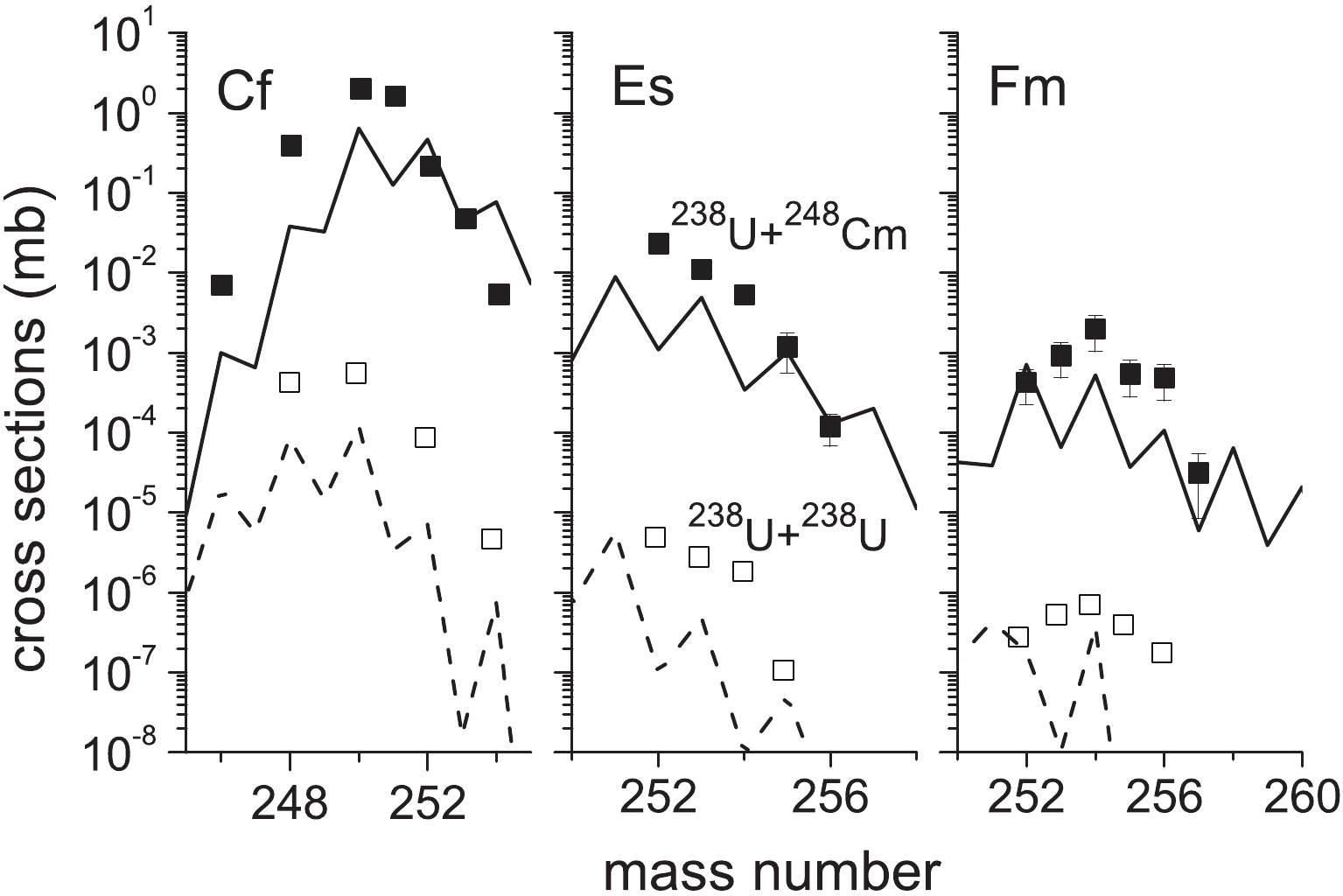HTML
--> --> -->Because of the limiting number of combinations for producing neutron-rich SHN in the stable beam-induced fusion reactions, many approaches were proposed in recent years to attain the island of stability. (i) Radioactive beam-induced fusion reactions could be candidates for producing neutron-rich SHN [7–9]. In present facilities, the intensities of radioactive beams are very low [10], which strongly suppresses the production rates. (ii) Stable beam-induced hot fusion reactions in charged particle evaporation channels are also investigated as a possible approach [11]. The disadvantage is that the Coulomb barrier prevents the charged particle evaporation in the cooling process. In our previous study [9], we compared the two approaches. It is shown that the production rates in the radioactive beam-induced reactions are comparable to those in stable beam-induced reactions in the charged particle evaporation channels. (iii) The multinucleon transfer (MNT) process is also suggested for the production of SHN [12–14]. To elucidate the mechanism of the MNT process and produce SHN, the reaction 238U + 238U has been investigated in many studies [15–21]. In Ref. [14], several low-energy collisions of heavy nuclei for producing SHN were studied based on multidimensional Langevin equations. The production of long-lived neutron-rich SHN in collisions of transuranium ions seems likely.
Recently, Wuenschel et al. attempted to produce SHN based on the MNT process [22]. Some promising results were presented. However, no direct evidence indicating that SHN are produced in the collisions of 238U + 232Th is shown. The reason is probably that the charge number of the target is not sufficiently high. The favorable combinations are always essential for producing unknown nuclei [23, 24]. In Ref. [25], one improved version of the DNS model (DNS-sysu) is introduced in detail. The DNS-sysu model can provide a reasonable description of MNT reactions for producing SHN. The reactions based on the 238U target are investigated in Ref. [25]. The production cross-sections decrease strongly with the increasing charge number of products, and the heavy projectiles are favorable for the production of trans-target nuclei. Based on the Langevin-type approach, several 238U induced MNT reactions, including with the target 254Es, are studied in Ref. [26]. It was shown that several actinide nuclei can be produced with the cross-sections larger than 1 μb.
The cross-sections of produced SHN in MNT reactions, based on targets with large charge number, are worth estimating. In this study, the MNT reactions based on radioactive targets 249Cf, 254Es, and 257Fm are investigated within the DNS-sysu model. The prospects of the radioactive projectile 239Pu for producing SHN are also investigated. In Section 2, the DNS-sysu model is described briefly. The results and discussion are presented in Section 3. Finally, I summarize the main results in Section 4.
 | (1) |
The PES is defined as
$ \begin{split}U(Z_{1}, N_{1}, \beta_{2}, R_{ \rm{cont}}) =& \Delta(Z_{1}, N_{1})+\Delta(Z_{2}, N_{2})\\ &+V_{ \rm{cont}}(Z_{1}, N_{1}, \beta_{2}, R_{ \rm{cont}})\\ &+\frac{1}{2}C_{1}(\beta_{2}^{1}-\beta_{2}^{ \rm{p}})^{2}+\frac{1}{2}C_{2}(\beta_{2}^{2}-\beta_{2}^{ \rm{t}})^{2}, \end{split}$  | (2) |
The cross-sections of the primary products can be calculated as
$ \begin{split}{{\sigma _{{\rm{pr}}}}({Z_1},{N_1},{E_{{\rm{c}}.{\rm{m}}.}})} =& {\frac{{\pi {\hbar ^2}}}{{2\mu {E_{{\rm{c}}.{\rm{m}}.}}}}\sum\limits_{J = 0}^{{J_{{\rm{max}}}}} {(2J + 1)} {T_{{\rm{cap}}}}(J,{E_{{\rm{c}}.{\rm{m}}.}})}\\&{\times \sum\limits_{{\beta _2}} P ({Z_1},{N_1},{\beta _2},{E_{{\rm{c}}.{\rm{m}}.}}).}\end{split} $  | (3) |
In the DNS-sysu model, with consideration of the deformation evolution, the excitation energy of primary products can be calculated with following equation [25].
$ \begin{split}E^{*}_{Z_{i},N_{i},J} =& \frac{Z_{i}+N_{i}}{A_{ \rm{tot}}}\\&\times\! \frac{\sum\limits_{\beta_{2}}[ P(Z_{i},N_{i},\beta_{2},J,t\!=\! \tau_{ \rm{int}}) E^{*}_{ \rm{DNS}}(Z_{i},N_{i},\beta_{2},J,t \!=\! \tau_{ \rm{int}})]}{\sum\limits_{\beta_{2}} P(Z_{i},N_{i},\beta_{2},t = \tau_{ \rm{int}})}. \end{split}$  | (4) |
The total kinetic energy loss (TKEL) for the configuration (Z1, N1, β2) calculated in the DNS-sysu model as shown in Ref. [27] can be written as
${\rm{TKEL}}=E_{\rm{diss}}+V_{\rm{cont}}(Z_{\rm p}, N_{\rm p},R_{\rm{cont}})-V_{\rm{cont}}(Z_1,N_1,\beta_2,R_{\rm{cont}} ). $  | (5) |
In the cooling process, the statistical model is applied with the Monte Carlo method [25]. In the ith de-excitation step, the probability of the s event can be written as
$ P_{\rm s}(E^{*}_{i}) = \frac{\Gamma_{\rm s}(E^{*}_{i})}{\Gamma_{ \rm{tot}}(E^{*}_{i})}, $  | (6) |
 Figure1. Yields of isotopes produced in MNT reactions 238U + 248Cm [31] and 238U + 238U [32]. Curves show calculations of DNS-sysu model.
Figure1. Yields of isotopes produced in MNT reactions 238U + 248Cm [31] and 238U + 238U [32]. Curves show calculations of DNS-sysu model.The above behavior encouraged me to explore the possibilities of producing SHN in the MNT reactions based on radioactive targets. Figure 2 shows the calculated producted cross-sections of isotopes with
 Figure2. (color online) Predictions of cross-sections for produced isotopes with Z = 100–109 in MNT reactions 238U + 254Es, 238U + 257Fm, 239Pu + 254Es, 239Pu + 257Fm, 238U + 249Cf, and 238U + 238U, the corresponding incident energies are 962, 970, 982, 991, 950, and 902 MeV, respectively. Circles on curves denote unknown SHN.
Figure2. (color online) Predictions of cross-sections for produced isotopes with Z = 100–109 in MNT reactions 238U + 254Es, 238U + 257Fm, 239Pu + 254Es, 239Pu + 257Fm, 238U + 249Cf, and 238U + 238U, the corresponding incident energies are 962, 970, 982, 991, 950, and 902 MeV, respectively. Circles on curves denote unknown SHN.Moreover, the 239Pu projectile can remarkably enhance the production yields in the neutron-deficient region, because of the high proton richness in 239Pu. However, to produce neutron-rich isotopes, the cross-sections in the 239Pu induced reactions have little advantage over those in the 238U induced reactions. I also show the calculated results of the reaction 238U + 238U. Based on the calculated cross-sections, there is little chance to produce SHN by the 238U + 238U reaction.
Based on the calculated cross-sections, the reaction 239Pu + 257Fm is more likely to produce SHN. As shown in Ref. [14, 25], the production cross-sections of SHN are strongly dependent on the incident energy. Indeed, although in same reaction, to produce different objective nuclei, the optimal incident energies are usually different [33]. Therefore, the incident energies for producing specific nuclei should be chosen carefully. Here, I only estimate the possibilities of producing SHN in MNT reactions. The incident energy of 1.3V
